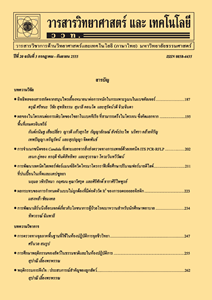ความเข้าใจแบบรูปพฤติกรรมของไก่ชนเพื่อการประเมินสวัสดิภาพ
Main Article Content
Abstract
บทคัดย่อ
การสังเกตความเปลี่ยนแปลงของพฤติกรรมเป็นวิธีหนึ่งที่ถูกนำมาใช้ประเมินสวัสดิภาพของปศุสัตว์ ทั้งในทางวิทยาศาสตร์และทางคลีนิค งานวิจัยครั้งนี้มีวัตถุประสงค์เพื่อศึกษาการจัดสรรเวลาและแบบรูปพฤติกรรมตอนกลางวันของไก่ชนในช่วงก่อนและหลังการแข่งขันชนไก่ ไก่พื้นเมืองเต็มวัยเพศผู้ 6 ตัว เลี้ยงและฝึกเพื่อการแข่งขันชนไก่ ณ มหาวิทยาลัยธรรมศาสตร์ ศูนย์รังสิต จังหวัดปทุมธานี ระหว่างวันที่ 1 เมษายน ถึง 31 พฤษภาคม พ.ศ.2556 แยกเลี้ยงไก่แต่ละตัวไว้ในสุ่มไม้ไผ่ขนาดเส้นผ่านศูนย์กลาง 80 เซนติเมตร ภายในโรงเรือนแบบกึ่งเปิด บันทึกพฤติกรรมไก่ก่อนและหลังแข่งขัน 1 วัน โดยนักสังเกตที่ได้รับการฝึกฝน 2 คน ระหว่างเวลา 06:00-18:00 น. ด้วยวิธีสุ่มสังเกตแบบมองกวาดและสุ่มสังเกตเฉพาะพฤติกรรม การแข่งขันใช้เวลา 22 นาที ระหว่างเวลา 07:00-09:30 น. โดยจับคู่กับไก่ชนอีก 6 ตัว ที่มีน้ำหนักตัวใกล้เคียงกัน ผลการศึกษาพบว่าโดยทั่วไปไก่ชนใช้เวลาส่วนใหญ่ตื่นตัวหรือพักผ่อนในท่ายืนหรือนั่ง (> 60 %) รองลงมา ได้แก่ การไซร้ขน (> 10 %) ในช่วงภายหลังการแข่งขัน ไก่ใช้เวลาตื่นตัว ดื่มน้ำ ขัน ร้องเตือน เกา พองขนแผงคอ และกระพือปีกน้อยลง (P < 0.05) ในขณะที่ใช้เวลาพักผ่อนและเดินนานกว่าช่วงก่อนการแข่งขันชนไก่ (P < 0.05) นอกจากนี้ยังพบว่าภายหลังการแข่งขัน ไก่มีแนวโน้มใช้เวลากินอาหารนานขึ้น (P < 0.10) จากการศึกษาครั้งนี้ชี้ให้เห็นว่าการเปลี่ยนแปลงพฤติกรรมของไก่ชน ยกตัวอย่าง การลดลงของการตื่นตัวและความถี่ของการขัน อาจใช้เป็นตัวบ่งชี้ถึงความเครียดของไก่ที่เกิดขึ้นจากการแข่งขันชนไก่ได้
คำสำคัญ : ไก่ชน; การจัดสรรเวลา; พฤติกรรม; สวัสดิภาพ; ความเครียด
Abstract
Changes in behaviour have long been used both scientific and clinical assessment of welfare in livestock. The aim of this study was to investigate diurnal time budgets and activity patterns of Thai fighting cocks (Gallus domesticus) before and after fighting. Six mature Thai native cocks were raised and trained for fighting competition at Thammasat University, Rangsit Centre, Pathum Thani Province from 1 April to 31 May 2013. Each cock was kept individually in a 80-cm diameter, bamboo coop in a semi-open barn. The behaviour of cocks was individually recorded using scan and behaviour sampling methods by two trained observers between 06:00 and 18:00 h on the day before and the day after fighting. Fights were conducted during the intermediate day between 07:00 and 09:30 h, within single bouts lasting 22 minutes, with the six subject cocks matched against cocks of similar weight. Both before and after fighting, cocks spent the majority of time alert or resting (> 60 %) following by preening (> 10 %). In the period after fighting, cocks spent less time alert, drinking, crowing, alarm calling, scratching, raising hackles and wing flapping (P < 0.05), and spent more time resting and walking than in the period before fighting (P < 0.05). Cocks also tended to spend more time eating (P < 0.10) after fighting than before. These results suggest that changes in fighting cocks’ behaviour, such as reduced alertness and frequency of crowing, may be indicative of post-fighting stress.
Keywords: fighting cock, time budget, behaviour, welfare, stress


